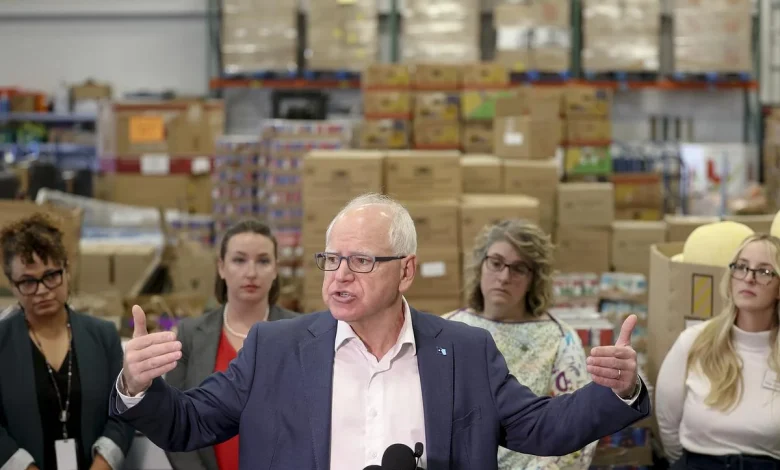Could Minnesota use its rainy-day fund to cover SNAP benefits?

As the federal shutdown careens into its second month, Minnesota DFLers excoriated the U.S. Department of Agriculture for not using a rainy-day fund toward the 440,000 Minnesotans who receive Supplemental Nutrition Assistance Program (SNAP) benefits.
Attorney General Keith Ellison even joined a lawsuit against the Trump administration on Tuesday, saying that the USDA has defied a congressional appropriation by not tapping into emergency funds. A federal judge has relieved immediate concerns about people losing benefits by ruling Friday that the administration must use the emergency fund. But it won’t cover the full cost of benefits for the month of November, and the Trump administration had not yet responded to the ruling.
The governor’s office has said Minnesota will lose $73 million in federal funding in November toward the SNAP program, an average of $166 per recipient, which they use to spend on food through a state-issued debit card.
But Minnesota has a rainy-day fund of its own. And a budget surplus. They add up to about $5.1 billion, money that could easily cover short-term benefits for SNAP plus the Low Income Heating and Energy Assistance Program (LIHEAP).
Last winter, 125,000 Minnesotans participated in the LIHEAP program getting about $550 in federal funds over the course of the winter toward their heating bill. Over 75,000 Minnesotans have already applied for the program this year, according to the Minnesota Department of Commerce.
Related: Who a rainy-day fund for shutdown-affected benefits would help in Minnesota
Using state money to cover any lost federal funds, though, would require an act of the Minnesota Legislature. That means Gov. Tim Walz would have to call a special session, as the Legislature is not scheduled to reconvene until February.
Sen. John Marty, DFL-Roseville and chair of the Senate Finance Committee, said the state needs to consider what it could do to assist Minnesotans.
“I think it is an absolute crisis. People are going to die from this. There is going to be a protein shortage,” Marty said in an interview before a federal judge issued a temporary reprieve. “It is our obligation to society to do anything in our power to address this.”
The federal judge’s ruling Friday makes the discussion over whether to call a special session moot for now. But even before the judge’s ruling Walz said he considers helping these recipients to be almost entirely the responsibility of the federal government.
“The Governor has made clear that the state does not have the ability to backfill the billions we receive every month from the federal government,” a Walz spokesperson emailed Friday. “This week he announced $4 million in emergency food support, but more importantly he continues to urge the Trump Administration to release the funds it has set aside for exactly this situation.”
Senate Majority Leader Erin Murphy, DFL-St. Paul, also pinned the shutdown on the Trump administration, though Murphy indicated a willingness to at least consider tapping into the state’s surplus.
“I’m open to discussions about how to strategically invest and save at the state level, but we could never replace these massive amounts being withheld and misspent by a federal government that already takes much more from Minnesotans than it gives back,” Murphy said in a statement.
House Speaker Lisa Demuth, R-Cold Spring, and Senate Minority Leader Mark Johnson, R-East Grand Forks did not respond by Friday afternoon as to whether they would support a special session to tap the budget surplus.
Here’s an explanation of why Minnesota has extra cash on hand that it could use to cover for missing federal funds.
Budget balance
The two-year budget the Legislature passed and Walz signed into law in June has a projected $1.9 billion budget balance, or surplus.
This balance is based off of a Minnesota Management and Budget (MMB) forecast of the state’s economy between now and June 30, 2027. If everything goes exactly as MMB anticipates, the state will not just cover all its expenses over the next two years, but have $1.9 billion in unused revenue at the end of the budget cycle.
The state’s economic forecast is subject to change. Indeed, MMB is scheduled to release new economic projections in November that could revise the $1.9 billion figure up or down.
Also, the reason the governor and state lawmakers gave themselves such a cushion is that they project expenses will exceed revenues in the next two-year budget period, which begins July 1, 2027.
“Keep in mind that we are still projecting a $1.1 billion shortfall in the fiscal-year 2028-2029 biennium, and that the net revenues of one biennium flow into the next, helping improve that biennium’s outlook,” emailed Patrick Hogan, spokesperson for MMB.
Marty said that Minnesota’s four-year budget planning, unusual among states, is admirable.
“I think Minnesotans can be proud of the fact we think through the budget rationally,” he said.
The rainy-day fund and cash flow account
Once the Legislature taps the $1.9 billion from the surplus, it still has $3.2 billion available in budget reserves, or what is informally known as the rainy-day fund. It also has $350 million lying around in what is called the cash flow account that ensures the state can meet its obligations.
Hogan explained that, per state statute, the Legislature and governor can only use the rainy-day fund and this cash flow account when a “negative budgetary balance is projected,” that is, when anticipated state expenses exceed revenue.
Since the rainy-day fund was established in 1981, the state has rarely used it to make up for lost federal money, though there was a modest $9 million the state took from the reserve in 1996 toward the LIHEAP program.
“Maintaining adequate reserves and cash flow in keeping with statute is important for Minnesota’s fiscal health,” Hogan stated. “Those funds are not designed to cover the federal government’s obligations.”
But the federal government is also not designed to shut down for two months. If the stalemate in Congress does not end next week, it will be the longest shutdown in federal history, surpassing the 35-day mark set in 2019.
Kathryn Vesey White, who tracks state’s rainy-day funds as the director of budget process studies at the National Association of State Budget Officers, said Minnesota and other states are entering uncharted waters.
“I am not aware of prior instances of a state using rainy-day funds in response to the impacts of a federal shutdown,” White said. “I would also note that SNAP and other safety net programs have not been disrupted in previous shutdowns in the way they are during the current shutdown.”
Editor’s note: This story has been updated to clarify Sen. John Marty’s position on a special session to use state funds to cover SNAP benefits. While Marty expressed the need to do something, he said he stopped short of calling for a special session. The story was further updated to remove a sentence that mischaracterized Marty’s view about using state funds. He said using state funds to cover missing federal dollars would put the state in a precarious financial position, especially if economic conditions worsen.





